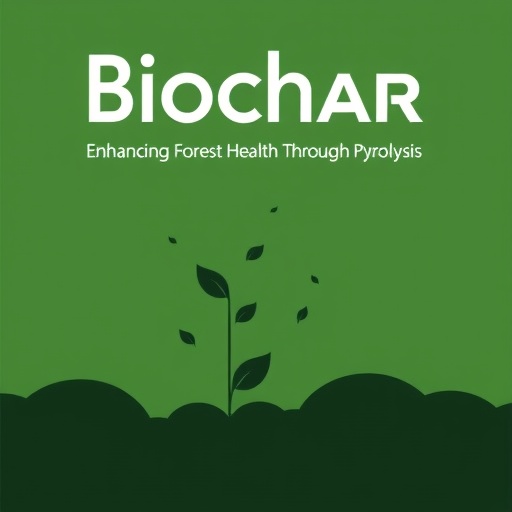In a groundbreaking study, researchers led by Wang, L., Joseph, S., and Feng, W. explore the multifaceted advantages of forest surface fuel biochar through comprehensive assessment of its performance, pyrolysis mechanisms, and environmental functions. As the world faces escalating climate challenges, the search for sustainable and effective carbon management solutions becomes increasingly critical. This study sheds light on the transformative potential of biochar derived from forest surface fuels, unveiling its versatility and presenting new insights that could shape future environmental management strategies.
Biochar, a stable carbon-rich material produced from organic matter through pyrolysis, has garnered significant attention as a means to sequester carbon, enhance soil fertility, and mitigate greenhouse gas emissions. The research team meticulously describes the pyrolysis process that converts forest residues into biochar, emphasizing the temperature and time parameters that optimize its chemical structure and function. This nuanced understanding of pyrolysis not only informs the production of high-quality biochar but also underlines the importance of various feedstocks, particularly those derived from forest fire hazardous areas.
The study delves into the performance metrics of biochar as a soil amendment, illustrating how its physicochemical properties can profoundly influence soil health and plant productivity. One of the key findings highlights biochar’s ability to retain moisture and nutrients, which are critical factors that contribute to enhanced plant growth. By integrating biochar into agricultural practices, farmers can potentially increase crop yields while simultaneously addressing soil degradation, a challenge that has longstanding implications for global food security.
In addition to its agricultural benefits, the research investigates the environmental functions of biochar, particularly its role in carbon sequestration. Biochar acts as a long-term carbon sink, sequestering carbon dioxide that would otherwise contribute to atmospheric greenhouse gas levels. This characteristic is especially crucial in the context of climate change mitigation strategies, as the addition of biochar to soils could lead to significant reductions in carbon emissions over time.
Moreover, the authors detail the complex mechanisms underlying the pyrolysis process, emphasizing how the temperature at which biomass is pyrolyzed affects the resulting biochar’s chemical compositions and its subsequent performance in various applications. At higher pyrolysis temperatures, for example, biochar exhibits increased carbon content and stability, making it a more effective long-term carbon sink. Conversely, lower temperature pyrolysis can yield biochar with desirable nutrient properties for agricultural applications.
The research goes further by assessing the environmental implications of widespread biochar use, particularly its potential to improve soil structure and mitigate soil erosion. As increasingly severe weather events threaten soil integrity, the application of biochar could provide a protective measure, ensuring greater resilience against erosion and degradation. These insights underscore the dual role of biochar not only as a tool for agricultural productivity but also as a means for environmental restoration and resilience.
Additionally, the authors address the economic feasibility of biochar production, considering factors such as feedstock availability, processing costs, and market opportunities. The analysis presents a compelling case for biochar as a viable economic product that can be integrated into existing forest management and agricultural systems, providing a win-win solution for both environmental and economic sustainability.
Crucially, the study emphasizes the importance of localized research in understanding the context-dependent effects of biochar application. Due to variations in soil types, climatic conditions, and crop species, the researchers advocate for site-specific trials to optimize biochar application strategies and maximize the benefits tailored to local agricultural practices.
The authors also highlight the challenges and barriers to biochar adoption in agricultural systems, such as limited awareness among farmers and initial investment costs. To address these impediments, the research calls for educational initiatives and stakeholder engagement to demonstrate the long-term benefits of biochar, thereby facilitating its acceptance and integration into agricultural practices.
In summary, this research presents a holistic view of forest surface fuel biochar, connecting its production through pyrolysis to diverse agricultural and environmental functions. By investigating its capacity to sequester carbon, improve soil health, and mitigate the impacts of climate change, Wang, L. and colleagues make a strong case for the urgent need to explore and promote biochar in future environmental management strategies.
As the world grapples with pressing environmental issues, the insights provided in this study are more relevant than ever. The vast potential of forest surface fuel biochar as a sustainable solution could not only help in mitigating climate change but also aid in fostering resilient agricultural practices. The collaborative effort from the authors marks a promising step towards a deeper understanding of how innovative biomass utilization can contribute to a sustainable future.
This study is pivotal in showing the myriad benefits of biochar, suggesting that, when effectively harnessed, it could play a significant role in transitioning towards environmentally responsible practices. As research continues to evolve, the implications of these findings could steer policy and direct funding towards biochar initiatives, making them a central component in both agricultural and environmental contexts.
The research led by Wang, L. et al. signifies a robust framework for cultivating an understanding around biochar and its potential impacts, shining a light on the possibilities that lie ahead for both our climate and agriculture.
Subject of Research: The performance, pyrolysis mechanism and environmental functions of forest surface fuel biochar.
Article Title: The performance, pyrolysis mechanism and environmental functions of forest surface fuel biochar.
Article References:
Wang, L., Joseph, S., Feng, W. et al. The performance, pyrolysis mechanism and environmental functions of forest surface fuel biochar.
Commun Earth Environ (2025). https://doi.org/10.1038/s43247-025-03016-3
Image Credits: AI Generated
DOI:
Keywords: Biochar, pyrolysis, carbon sequestration, soil health, agricultural sustainability, climate change mitigation, environmental restoration.




